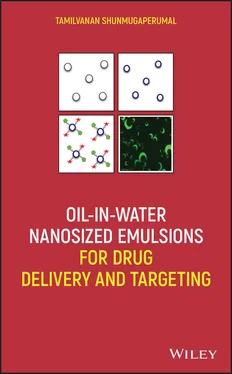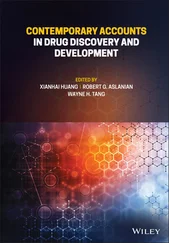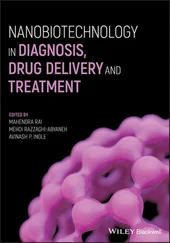1 ...7 8 9 11 12 13 ...27 29 Merisko‐Liversidge, E. and Liversidge, G.G. (2011), Nanosizing for oral and parenteral drug delivery: a perspective on formulating poorly‐water soluble compounds using wet media milling technology, Adv. Drug Deliv. Rev., 63 (6), 427–440. doi:10.1016/j.addr.2010.12.007
30 Mizushima, Y. (1996), Lipid microspheres (lipid emulsions) as a drug carrier—an overview, Adv. Drug Deliv. Rev., 20 (2–3), 113–115. doi:10.1016/0169‐409X(95)00114‐M
31 Möschwitzer, J.P. (2013), Drug nanocrystals in the commercial pharmaceutical development process, Int. J. Pharm., 453 (1), 142–156. doi:10.1016/j.ijpharm.2012.09.034
32 Müller, R.H. and Keck, C.M. (2012), Twenty years of drug nanocrystals: where are we, and where do we go?, Eur. J. Pharm. Biopharm., 80 (1), 1–3. doi:10.1016/j.ejpb.2011.09.012
33 Napper, D.H. (1983), Polymeric Stabilisation of Colloidal Dispersions, Academic Press, London.
34 Piemi, M.P., Korner, D., Benita, S. et al. (1999), Positively and negatively charged submicron emulsions for enhanced topical delivery of antifungal drugs, J. Control. Release, 58, 177–187. doi:10.1016/s0168‐3659(98)00156‐4
35 Shah, D.A., Murdande, S.B., and Dave, R.H. (2016), A review: pharmaceutical and pharmacokinetic aspect of nanocrystalline suspensions, J. Pharm. Sci., 105 (1), 10–24. doi:10.1002/jps.24694
36 Shegokar, R. and Müller, R.H. (2010), Nanocrystals: industrially feasible multifunctional formulation technology for poorly soluble actives, Int. J. Pharm., 399 (1–2), 129–139. doi:10.1016/j.ijpharm.2010.07.044
37 Skinner, L.M. and Sambles, J.R. (1972), Kelvin equation—a review, J. Aerosol. Sci., 3 (3), 199–210. doi:10.1016/0021‐8502(72)90158‐9
38 Smith, A. and Davis, S.S. (1973), Proceedings: the role of molecular diffusion in the bulk stability of o‐w hydrocarbon emulsions, J. Pharm. Pharmacol., 25 (Suppl), 117.
39 Tadros, T.F. (1982), Polymer adsorption and colloid stability, in: The Effect of Polymer on Dispersion Properties, Academic Press, London.
40 Tadros, T.F., Izquierdo, P., Esquena, J. et al. (2004), Formation and stability of nanoemulsions, Adv. Colloid Interf. Sci., 108–109, 303–318. doi:10.1016/j.cis.2003.10.023
41 Tamilvanan, S., Gursoy, R.N., and Benita, S. (2002), Emulsion‐based delivery systems for enhanced drug absorption, Pharm. Technol., 131, 156–161.
42 Taniguchi, N. (1974), On the basic concept of nanotechnology, in: Proceedings of the International Conference on Production Engineering, Tokyo, Part‐II, Japan Society of Precision Engineering, Japan, pp. 18–23.
43 Taylor, P. (1998), Ostwald ripening in emulsions, Adv. Colloid.Interf. Sci., 75 (2), 107–163. doi:10.1016/S0001‐8686(98)00035‐9
44 Taylor, P. and Ottewill, R.H. (1994), Ostwald ripening in O/W miniemulsions formed by the dilution of O/W microemulsions, in: Progress in Colloid and Polymer Science, Springer, Berlin, Germany, pp. 199–203.
45 Tuomela, A., Hirvonen, J., and Peltonen, L. (2016), Stabilizing agents for drug nanocrystals: effect on bioavailability, Pharmaceutics, 8 (2), 1–18. doi:10.3390/pharmaceutics8020016
46 Vandamme, T.F. (2002), Microemulsions as ocular drug delivery systems: recent developments and future challenges, Prog. Retin. Eye Res., 21, 15–34. doi:10.1016/s1350‐9462(01)00017‐9
47 Wagner, C. (1961), Theorie der alterung von niederschlägen durch umlösen (ostwaldreifung), Z. Elektrochem., 65 (7–8), 581–591. doi:10.1002/bbpc.19610650704
48 Wassvik, C.M., Holmen, A.G., and Draheim, R. (2008), Molecular characteristics for solid‐state limited solubility, J. Med. Chem., 51 (10), 3035–3039. doi:10.1021/jm701587d
49 Yotsuyanagi, T., Higuchi, W.I., and Ghanem, A.H. (1973), Theoretical treatment of diffusional transport into and through an oil‐water emulsion with an interfacial barrier at the oil‐water interface, J. Pharm. Sci., 62, 40–43. doi:10.1002/jps.2600620106
CHAPTER 2 FORMULATION DEVELOPMENT OF OIL‐IN‐WATER NANOSIZED EMULSIONS
SYED NAZRIN RUHINA RAHMAN *AND TAMILVANAN SHUNMUGAPERUMAL
Department of Pharmaceutics, National Institute of Pharmaceutical Education and Research (NIPER), Guwahati, Assam, India
1 2.1. Introduction
2 2.2. FDA‐approved oils, emulsifiers, and auxiliary or miscellaneous excipients 2.2.1. Issues related to oil selection to make the o/w nanosized emulsions for medical application 2.2.2. Issues related to emulsifiers selection to stabilize the o/w nanosized emulsions for medical application 2.2.3. Importance of charge‐stabilized nanosized emulsions 2.2.4. Importance of neutral‐charged (sterically‐stabilized) nanosized emulsions 2.2.5. Advantages of nanosized emulsions stabilized by mixed or multicomponent emulsifier molecules 2.2.6. ‘Stealth’ property of nanosized emulsions: in vitro demonstrations 2.2.7. Advantages of stabilizers in nanosized emulsions 2.2.8. Miscellaneous additives
3 2.3. Current and near future direction2.3.1. Colloidal particles‐stabilized emulsions
4 2.4 Lipophilic API incorporation pattern into nanosized emulsions 2.4.1. Extemporaneous API Addition 2.4.2. De Novo Emulsion Preparation 2.4.3. Interfacial Incorporation Approach 2.4.4. Incorporation of Antibodies, DNA Protein, Oligonucleotide, or Heat Labile Molecules
5 2.5 QbD approach to optimize emulsion 2.5.1. Case study for optimizing systematically a formula to make o/w nanosized Emulsions
6 2.6. Conclusion References
EXPANSION OF ABBREVIATIONS
apoapolipoproteinAIartificial intelligenceAPIactive pharmaceutical ingredientCCDcentral composite designCKCcetalkonium chlorideCMAscritical material attributesCMCchemistry, manufacturing, and controlCPPscritical process parametersCQAscritical quality attributesCTABcetyltrimethyl ammonium bromideDBPdi‐butyl‐phthalate2DEHPAbis(2‐ethylhexyl) hydrogen phosphateDMPCdimyristoylphosphatidylcholineDMPEdimyristoylphosphatidylethanolamine DOTAP1,2‐dioleoyl‐sn‐glycero‐3‐trimethylammoniumpropane2D PAGEtwo‐dimensional polyacrylamide gel electrophoresisDPPCdipalmitoylphosphatidylcholineELMemulsion liquid membranesFbDFormulation by DesignFMEAfailure mode effect analysisHLBhydrophilic–lipophilic balanceICimpression cytologyICHInternational Council for HarmonisationIVCMin vivo confocal microscopyMAmaterial attributeMCTmedium‐chain triglyceridesMLmachine learning MPSmean particle sizeNCEnew chemical entityNPEO10nonylphenol‐poly (ethylene oxide)OFATone‐factor‐at‐a‐timeO/Woil‐in‐waterPBCApoly(n‐butylcyanoacrylate)PCphosphatidyl choline 6‐PCn‐hexanoyl lysolecithinPDIpolydispersity indexPEOpolyoxyethylenePFOBperfluorooctyl bromidePPprocessing parameterPPOpolyoxypropyleneTPGStocopheryl polyethylene glycol 1000 succinateQACquaternary ammonium compoundQbDQuality by DesignQbTQuality by TestingQRMquality risk managementQTPPquality target product profileREMrisk estimation matrixRPNrisk priority numberSDSsodium dodecyl sulfate ZPzeta potential
Therapeutically, the oil‐in‐water (o/w) nanosized emulsions are used mainly as delivery carriers for lipophilic active pharmaceutical ingredient (API) molecules that show pharmacological activities after administration via parenteral, ocular, and transdermal routes. Furthermore, the o/w nanosized emulsions having anionic, cationic, or neutral charged dispersed oil droplets can be made especially by changing the emulsifiers so that the first step of engineered droplet surfaces could be obtained to extract multifunctional activities. The second step of engineered droplet surfaces in emulsions usually attains by decorating the droplet surface with anchoring or homing moiety either by conjugation or simple adsorption reaction. By combining both the surface charge optimization and engineered droplet surfaces, the o/w nanosized emulsions are indeed in recent years useful for API delivery and/or targeting to otherwise inaccessible internal organs of the human body (Tamilvanan 2009).
Читать дальше












